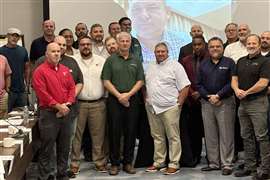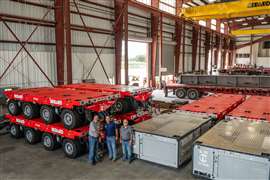On the rise!
29 November 2016
.jpg)
In an otherwise uncertain economy, the tower crane market in North America is trending upward.
“The tower crane market has improved substantially over the last three years,” said Christian Chalupny, president of Morrow Equipment. “We had a very slow period in 2010 and 2011 after the financial crisis. But this year we are achieving the best results in our history. The market has recovered.”
Morrow Equipment is the exclusive distributor of Liebherr tower cranes in North America. The company owns the largest fleet of tower cranes in North America, Chalupny said, “by a wide margin, and we have the third largest tower crane fleet in the world.”
What is fueling this recovery? Chalupny points to strong activity in the commercial office building sector and the residential and health care sectors.
“There is good activity coming from these sectors,” he said. “And it’s not near as speculative as it was in 2007 and 2008. We are very optimistic [regarding the outlook] for the next three years.”
According to Stephen Jehle, president of P&J Arcomet, there are high levels of tower crane activity nationwide.
“From Miami to LA, pretty much every major metropolitan area is seeing strong demand for tower cranes,” said Jehle. P&J Arcomet supplies cranes for markets across the country. The company recently became the exclusive distributor for Zoomlion tower cranes.
Urban demand
Highest demand can be mapped to the United States’ most populated cities, which are undergoing renovations and where larger-scale construction projects are taking place.
“Currently the most concentrated demand is in states like Texas, Florida and other states with large city centers as in California with Los Angeles and San Francisco,” said Ruedi Van Coppenolle, manager of tower cranes, North America, for Terex. “The largest driver of tower crane rental and sales are related to infrastructure work like bridges by the government, but also the private industry with commercial and private high-rise buildings.”
Morrow’s Chalupny said demand is also strong in the Pacific Northwest and Hawaii. He pointed to cities in the Northeast and in the Atlanta, GA region. The fluidity of the demand is a significant factor when it comes to the distribution of tower cranes.
“There are pockets of high activity at the moment and this is due to the number of cranes in a particular market,” said Dick Huitema, area manager for JASO. “They continually change so if an area has high demand then this will change and tower cranes move into the area.”
JASO has been in the U.S. market for two years. Its distributor, Crane Tech Solutions (CTS) has been in the global market for over 10 years. The JASO brand distinguishes itself by offering a European quality crane with local parts and service.
With the continual growth of the market comes the need for the various manufacturers to set themselves apart.
“We are a small company if you compare your turnover with Liebherr, Terex or Manitowoc, and we can’t compete with these big guys in every way,” said Juan Ballester of Grúas Sáez. “So we try to focus in the small and medium-size companies, where our great after-sales service can make a difference. We are sending a lot of spare parts to our warehouse in Denver and we want people to realize that we are people that answer the phone, that can make quick decisions and that care about our customers.”
Customer satisfaction and service also play a substantial role. Paired with popularized European design elements, many companies have managed to build a steady client base for fleet owners, rental customers and contractors.
“Wolffkran focuses on the highest quality in everything we do,” said K. Matthew Dobbs, vice president of Wolffkran, Inc. “We feel our products, services and our people distinguish us as a leader in the marketplace. We don’t try and be all things to all people. Our business approach is centered around our core fundamentals and implementing to the highest standards possible.”
Delivering results
Terex is one of the larger crane companies with a reputation for producing reliable and quality machines.
“There are thousands of cranes from North to South from East to West that are delivering results every day on job sites,” said Van Coppenolle. “Difficulties on the job can be expected, but we are always behind our customers. We have proven ourselves throughout the years as a good manufacturer focused on the customer.”
State-of-the-art advancements are crucial when it comes to staying ahead of the competition in such a viable marketplace.
“We’ve always been an innovative company, Manitowoc as a whole,” said Michael Heacock, vice president of sales for Manitowoc’s Potain tower crane line in North America. “All of our products are very innovative, and that’s a big piece of what we feel sets us apart. You can see that with our tower crane products that we have now.”
This year Manitowoc launched the HUP product line resulting in a more compact crane that gives the operator a staggering height advantage. But with so many different options and attributes to choose from, which tower cranes are the most sought after?
The most popular models for Grúas Sáez include the flat-top city cranes TL 55 5t, and the flat-top medium-size cranes TLS 65B 10t. According to JASO and CTS, the popularity changes depending on the size of the buildings and the required capacity. There is a high interest in 300 meter ton capacity cranes, JASO’s Huitema said.
“So far for us it has been the 21LC335-20T,” said Bill Carbeau, vice president business development for Linden Comansa America. “This is a 300 meter ton crane and a new design for 2016. We sell and rent it with the XL cabin, zoning and digital readout. This and all of our models have several features that allow for faster hook speeds using less power.”
Depending on the job site requirements, the tower crane users have a plethora of options to choose from to perfectly align with a client’s needs. The versatility of new models of tower cranes have seemingly aided in the growth and popularity.
“The SK 415-20, the SK 452-20 and the SK 575 hammerhead tower crane product continues being strong for Terex with the SK 415-20 & the SK 452-20 model leading the way,” said Van Coppenolle. “Both the SK 415-20 and the 452-20 are sister cranes with the same capacity rating, but with differences in the technology package that controls the lifting. These two cranes have a maximum jib length of 262.4 feet and a maximum capacity of 22 tons overall with a tip maximum capacity of 2.5 tons with a 262.4 foot jib.”
Morrow’s Chalupny points to the 300 to 500 meter ton range as the most in demand.
“That’s the largest part of our rental fleet and that’s where we see the biggest demand,” he said. “We are also seeing a trend for more luffing boom cranes and we have built our fleet with these Liebherr models. We have 60 in our fleet.”
ACT asked tower crane specialists to name their most interesting North American tower crane projects. From mountain tops to dams, the industry is steadily propelling a number of development ventures.
This month, Grúas Sáez will be erecting a Saez TLS 80 24t in the mountains above Boulder, CO at almost 10,000 feet of altitude to build a water treatment plant for the City of Boulder. According to Ballester, the project presents a challenge because the erection of the crane required a 500-ton mobile crane and the accessibility of the mobile crane to the job site will be quite difficult. The crane also has to be prepared to work at really low temperatures and to withstand wind gusts of up to 180 miles per hour.
Moving down South, P&J Arcomet’s work became a crucial element for an NFL team.
“We supplied five tower cranes in Dallas to help build the new Dallas Cowboys headquarters and training facility, called The Star,” said Jehle. “It was a lot of fun working on that project and getting to be around that organization.”
In addition, Arcomet placed a Comedil CTL630 and a Terex-Peiner SK415 on the Canadian Parliament building in Ottawa, Canada.
Dam work
One of Carbeau’s favorite projects is the Keeyask Dam Project in Upper Manitoba, Canada. This is the construction of a hydro dam and is using five Linden Comansa cranes all on travel under carriages with free standing heights up to 281 feet.
As the first to purchase the Terex SK 452-20, Maxim Crane Works erected a new tower crane on-site at a high rise commercial and residential project in Ohio. According to Matt Hyden, vice president of the Maxim’s tower crane division, the choice was easy since both the SK 415-20 and the SK 452-20 utilized all of the same structural components making the choice easy for fleet owners allowing interchangeability of components with both models. Maxim wanted the extra flexibility of speed options with the SK 452-20, but needed to maintain its fleet simplicity. The SK 452-20 allowed them to do this.
Another impressive job site includes the replacement of the Tappan Zee Bridge crossing the Hudson River in New York. Potain has some of the biggest tower cranes on the project, providing one for each column of the bridge suspension.
In this developing market, new model introductions are a common denominator for global tower crane manufacturers.
New models
Saez will show its H40 hydraulic self-erecting crane. Terex will show its SK 452-20 hammerhead tower crane. Linden Comansa America will display a LCL310-18T luffing jib tower crane at Con Expo.
“This will have the latest in technology and all the bells and whistles for tower cranes,” said Carbeau. “We are introducing our new LCL700 luffing jib tower crane in January at the factory in Spain.”
While Manitowoc Potain’s Heacock wasn’t at liberty to discuss any upcoming releases just yet, he did say that a lot of the new products that will be equipped with the Manitowoc CCS system. The Crane Control System involves implementing essentially the same display screen in platforms across the board.
“The logic and the theory is all the same across all of our platforms,” said Heacock. “It’s used for companies who have operators that are used to running a certain type of crane, maybe a crawler or a mobile. Rather than having to relearn a whole system, they only have to relearn the details. The joysticks are all literally the same. A lot of the components are the same in the cab. We’ve tried to standardize a lot of this.”
With the industry demand continuing to trend in an upward climb, and new technology and designs dominating ConExpo, 2017 could very likely be a promising year for the tower crane market.
STAY CONNECTED


Receive the information you need when you need it through our world-leading magazines, newsletters and daily briefings.
CONNECT WITH THE TEAM











